A Self-Adaptive Progressive Support Selection Scheme for Collaborative Wideband Spectrum Sensing
Abstract
1. Introduction
- (1)
- To reduce the complexity and the cost of cooperative wideband spectrum sensing, inspired by [30] in which the parallel hardware sensing channels are scattered on various SUs. Namely, the th secondary user is treated as the th compressed sampling channel. To mitigate multipath fading in the CR environment, we build the transmission loss model. In the fusion center (FC), the under-sampling data from SUs is multiplied by the transmission loss gain. Moreover, the influence of transmission loss on the support recovery performance is also discussed.
- (2)
- To self-adaptively achieve a high successful reconstruction probability of spectral support in a practical CR environment. Firstly, according to the theory of singular value decomposition [31], the internal relationship between noise singular values and useful signal singular values in a noisy signal is obtained. Then, because the tail singular values are mainly determined by noise, and the noise singular value has a linear characteristic, the proposed scheme uses the linear relationship to estimate the noise intensity by adding a known additive white Gaussian noise (AWGN) signal in the FC. Thirdly, with the contribution of the estimated noise singular values to the singular values of the noised-signal, we use a gradient and difference operation to estimate the sparsity order.
- (3)
- Given a false alarm probability () and transmission interference, the scheme uses the progressive support selection strategy to significantly decrease the probability of missing detection under low SNR levels.
2. System Model and Problem Statement
2.1. Basic Principle of the MWC
2.2. System Model
2.3. Problem Statement
3. Proposed PSS-SaDMWC Scheme
3.1. Preprocessing of PSS-SaDMWC Scheme
3.1.1. Estimation of Noise Intensity
3.1.2. Estimation of Sparsity Order
3.2. The Influence of Propagation Loss on Support Reconstruction
3.3. Support Selection Strategy Based on Progressive Operation
| Algorithm 1. The description of the PSS-SaDMWC scheme. |
| Parameters: , , , , , , , , , , and . Initializations: . I. DMWC compressed sampling
|
| Algorithm2. The ith support reconstruction with the progressive idea. |
| Input parameters: , , , , , . Obtain progressive spectral support:
|
4. Performance Evaluation and Analysis
4.1. Design Example and Performance Metrics
- (1)
- Generate the mixing signal randomly.
- (2)
- Generate the carrier frequency uniformly and randomly in .
- (3)
- Generate new sinc signal according to .
- (4)
4.2. Simulation Results and Analysis
5. Conclusions
Author Contributions
Acknowledgments
Conflicts of Interest
Appendix A

References
- Ding, G.; Wang, J.; Wu, Q.; Zhang, L.; Zou, Y.; Yao, Y.; Chen, Y. Robust spectrum sensing with crowd sensors. IEEE Trans. Commun. 2014, 62, 3129–3143. [Google Scholar] [CrossRef]
- Li, B.; Sun, M.; Li, X.; Nallanathan, A.; Zhao, C. Energy detection based spectrum sensing for cognitive radios over time-frequency doubly selective fading channels. IEEE Trans. Signal Process. 2015, 63, 402–417. [Google Scholar] [CrossRef]
- Quan, Z.; Zhang, W.; Shellhammer, S.J.; Sayed, A.H. Optimal spectral feature detection for spectrum sensing at very low SNR. IEEE Trans. Commun. 2011, 59, 201–212. [Google Scholar] [CrossRef]
- Akyildiz, I.F.; Lo, B.F.; Balakrishnan, R. Cooperative spectrum sensing in cognitive radio networks: A survey. Phys. Commun. 2011, 4, 40–62. [Google Scholar] [CrossRef]
- Sharma, S.K.; Lagunas, E.; Chatzinotas, S.; Ottersten, B. Application of compressive sensing in cognitive radio communications: A survey. IEEE Commun. Surv. Tutor. 2016, 99, 1–24. [Google Scholar] [CrossRef]
- Sun, H.; Nallanathan, A.; Wang, C.X.; Chen, Y. Wideband spectrum sensing for cognitive radio networks: A survey. IEEE Wirel. Commun. 2013, 20, 74–81. [Google Scholar]
- Donoho, D.L. Compressed sensing. IEEE Trans. Inf. Theory 2006, 52, 1289–1306. [Google Scholar] [CrossRef]
- Candès, E.J.; Wakin, M.B. An introduction to compressive sampling. IEEE Signal Process. Mag. 2008, 25, 21–30. [Google Scholar] [CrossRef]
- Yang, X.; Guo, Y.J.; Cui, Q.; Tao, X.; Huang, X. Random circulant orthogonal matrix based analog compressed sensing. In Proceedings of the 2012 IEEE Global Communications Conference (GLOBECOM), Anaheim, CA, USA, 3–7 December 2012; pp. 3605–3609. [Google Scholar]
- Yang, X.; Dutkiewicz, E.; Cui, Q.; Huang, X.; Tao, X.; Fang, G. Analog compressed sensing for multiband signals with non-modulated Slepian basis. In Proceedings of the 2013 IEEE International Conference on Communications (ICC), Budapest, Hungary, 9–13 June 2013; pp. 4941–4945. [Google Scholar]
- Tropp, J.A.; Laska, J.N.; Duarte, M.F.; Romberg, J.K.; Baraniuk, R.G. Beyond Nyquist: Efficient sampling of sparse band limited signals. IEEE Trans. Inf. Theory 2010, 56, 520–544. [Google Scholar] [CrossRef]
- Romberg, J. Compressive sensing by random convolution. SIAM J. Imaging Sci. 2009, 2, 1098–1128. [Google Scholar] [CrossRef]
- Bresler, Y. Spectrum-blind sampling and compressive sensing for continuous-index signals. In Proceedings of the 2008 Information Theory and Applications Workshop, San Diego, CA, USA, 27 January–1 February 2008; pp. 547–554. [Google Scholar]
- Ariananda, D.D.; Leus, G.; Tian, Z. Multi-coset sampling for power spectrum blind sensing. In Proceedings of the IEEE 2011 17th International Conference on Digital Signal Processing (DSP), Corfu, Greece, 6–8 July 2011; pp. 1–8. [Google Scholar]
- Ariananda, D.D.; Leus, G. Wideband power spectrum sensing using sub-Nyquist sampling. In Proceedings of the 2011 12th IEEE International Workshop on Signal Processing Advances in Wireless Communications (SPAWC), San Francisco, CA, USA, 26–29 June 2011; pp. 101–105. [Google Scholar]
- Mishali, M.; Eldar, Y.C. From theory to practice: Sub-Nyquist sampling of sparse wideband analog signals. IEEE J. Sel. Top. Signal Process. 2010, 4, 375–391. [Google Scholar] [CrossRef]
- Mishali, M.; Elron, A.; Eldar, Y.C. Sub-Nyquist processing with the modulated wideband converter. In Proceedings of the 2010 IEEE International Conference on Acoustics Speech and Signal Processing (ICASSP), Dallas, TX, USA, 14–19 March 2010; pp. 3626–3629. [Google Scholar]
- Mishali, M.; Eldar, Y.C.; Dounaevsky, O.; Shoshan, E. Xampling: Analog to digital at sub-Nyquist rates. IET Circuits Devices Syst. 2011, 5, 8–20. [Google Scholar] [CrossRef]
- Lexa, M.A.; Davies, M.E.; Thompson, J.S. Reconciling compressive sampling systems for spectrally sparse continuous-time signals. IEEE Trans. Signal Process. 2012, 60, 155–171. [Google Scholar] [CrossRef]
- Gai, J.; Fu, P.; Sun, J.; Lin, H.; Wu, L. A recovery algorithm of MWC sub-Nyquist sampling based on random projection method. Acta Electron. Sin. 2014, 42, 1686–1692. [Google Scholar]
- Mishali, M.; Eldar, Y.C. Reduce and boost: Recovering arbitrary sets of jointly sparse vectors. IEEE Trans. Signal Process. 2008, 56, 4692–4702. [Google Scholar] [CrossRef]
- Sun, W.; Wang, F.; Huang, Z.; Wang, X. Wideband spectrum fast sensing method based on improved multiple signal classification. J. Natl. Univ. Def. Technol. 2015, 37, 155–160. [Google Scholar]
- Yang, X.; Tao, X.; Guo, Y.J.; Huang, X. Subsampled circulant matrix based analogue compressed sensing. Electron. Lett. 2012, 48, 767–768. [Google Scholar] [CrossRef]
- Sun, W.; Huang, Z.; Wang, F.; Wang, X. Compressive wideband spectrum sensing based on single channel. Electron. Lett. 2015, 51, 693–695. [Google Scholar] [CrossRef]
- Zhang, J.; Fu, N.; Peng, X. Compressive circulant matrix based analog to information conversion. IEEE Signal Process. Lett. 2014, 21, 428–431. [Google Scholar] [CrossRef]
- Sun, W.; Huang, Z.; Wang, F.; Wang, X.; Xie, S. Wideband power spectrum sensing and reconstruction based on single channel sub-Nyquist sampling. IEICE Trans. Fundam. Electron. Commun. Comput. Sci. 2016, 99, 167–176. [Google Scholar] [CrossRef]
- Chen, W.; Yang, J.; Ma, J.; Li, S. New developments in maritime communications: A comprehensive survey. China Commun. 2012, 9, 31–42. [Google Scholar]
- Zhao, N. Joint optimization of cooperative spectrum sensing and resource allocation in multi-channel cognitive radio sensor networks. Circuits Syst. Signal Process. 2016, 35, 2563–2583. [Google Scholar] [CrossRef]
- Cohen, D.; Akiva, A.; Avraham, B.; Patterson, S.; Eldar, Y.C. Distributed cooperative spectrum sensing from sub-Nyquist samples for Cognitive Radios. In Proceedings of the 2015 IEEE 16th International Workshop on Signal Processing Advances in Wireless Communications (SPAWC), Stockholm, Sweden, 28 June–1 July 2015; pp. 336–340. [Google Scholar]
- Xu, Z.; Li, Z.; Li, J. Broadband cooperative spectrum sensing based on distributed modulated wideband converter. Sensors 2016, 16, 1602. [Google Scholar] [CrossRef] [PubMed]
- Drmac, Z. Accurate computation of the product-induced singular value decomposition with applications. SIAM J. Numer. Anal. 1998, 35, 1969–1994. [Google Scholar] [CrossRef]
- Cotter, S.F.; Rao, B.D.; Engan, K.; Kreutz, D.K. Sparse solutions to linear inverse problems with multiple measurement vectors. IEEE Trans. Signal Process. 2005, 53, 2477–2488. [Google Scholar] [CrossRef]
- Van, D.B.E.; Friedlander, M.P. Theoretical and empirical results for recovery from multiple measurements. IEEE Trans. Inf. Theory 2010, 56, 2516–2527. [Google Scholar]
- Tang, M.; Ding, G.; Wu, Q.; Xue, Z.; Tsiftsis, T. A joint tensor completion and prediction scheme for multi-dimensional spectrum map construction. IEEE Access 2016, 4, 8044–8052. [Google Scholar] [CrossRef]
- Sun, J.; Wang, J.; Ding, G.; Shen, L.; Yang, J.; Wu, Q.; Yu, L. Long-term spectrum state prediction: An image inference perspective. IEEE Access 2018, 6, 43489–43498. [Google Scholar] [CrossRef]
- Mishali, M.; Eldar, Y.C. The continuous joint sparsity prior for sparse representations: Theory and applications. In Proceedings of the 2007 2nd IEEE International Workshop on Computational Advances in Multi-Sensor Adaptive Processing, St. Thomas, VI, USA, 12–14 December 2007; pp. 125–128. [Google Scholar]
- Duarte, M.F.; Sarvotham, S.; Wakin, M.B.; Baron, D.; Baraniuk, R.G. Joint sparsity models for distributed compressed sensing. In Proceedings of the Workshop on Signal Processing with Adaptive Sparse Structured Representations (SPARS), Rennes, France, 16–18 November 2005; pp. 1–4. [Google Scholar]
- Khan, A.A.; Rehmani, M.H.; Reisslein, M. Cognitive radio for smart grids: Survey of architectures, spectrum sensing mechanisms, and networking protocols. IEEE Commun. Surv. Tutor. 2016, 18, 860–898. [Google Scholar] [CrossRef]
- Akyildiz, I.F.; Lee, W.Y.; Vuran, M.C.; Mohanty, S. NeXt generation/dynamic spectrum access/cognitive radio wireless networks: A survey. Comput. Netw. 2006, 50, 2127–2159. [Google Scholar] [CrossRef]
- Driessen, P.E. Prediction of multipath delay profiles in mountainous terrain. IEEE J. Sel. Areas Commun. 2000, 18, 336–346. [Google Scholar] [CrossRef]
- Chen, J.; Huo, X. Theoretical results on sparse representations of multiple-measurement vectors. IEEE Trans. Signal Process. 2006, 54, 4634–4643. [Google Scholar] [CrossRef]
- Majumdar, A.; Ward, R.K.; Aboulnasr, T. Algorithms to approximately solve NP hard row-sparse MMV recovery problem: Application to compressive color imaging. IEEE J. Emerg. Sel. Top. Circuits Syst. 2012, 2, 362–369. [Google Scholar] [CrossRef]
- Gai, J.; Fu, P.; Fu, N.; Liu, B. Sub-Nyquist sampling reconstruction algorithm based on SVD and MUSIC. Chin. J. Sci. Instrum. 2012, 33, 2073–2079. [Google Scholar]
- Liu, W.; Lin, W. Additive white Gaussian noise level estimation in SVD domain for images. IEEE Trans. Image Process. 2013, 3, 872–883. [Google Scholar] [CrossRef] [PubMed]
- Ravazzi, C.; Fosson, S.M.; Bianchi, T.; Magli, E. Signal sparsity estimation from compressive noisy projections via γ-sparsified random matrices. In Proceedings of the 2016 IEEE International Conference on Acoustics, Speech and Signal Processing (ICASSP), Shanghai, China, 20–25 March 2016; pp. 4029–4033. [Google Scholar]
- Tropp, J.A. Greed is good: Algorithmic results for sparse approximation. IEEE Trans. Inf. Theory 2004, 50, 2231–2242. [Google Scholar] [CrossRef]
- Candès, E.J.; Romberg, J. Sparsity and incoherence in compressive sampling. Inverse Probl. 2007, 23, 969–985. [Google Scholar] [CrossRef]
- Hu, Z.; Bai, Y.; Zhao, Y.; Zhang, Y. Support recovery for multiband spectrum sensing based on modulated wideband converter with SwSOMP Algorithm. In Proceedings of the 2017 1th EAI International Conference on 5G for Future Wireless Networks (5GWN), Beijing, China, 21–23 April 2017; pp. 1503–1516. [Google Scholar]
- Cao, K.; Lu, P.; Sun, C.; Zou, Y.; Wang, J.; Ling, L. Frequency locator polynomial for wideband sparse spectrum sensing with multichannel subsampling. IEEE Trans. Signal Process. 2018, 66, 789–803. [Google Scholar] [CrossRef]
- Çelebi, M.B.; Celebi, H.; Arslan, H.; Qaraqe, K. Spectrum sensing testbed design for cognitive radio applications. In Proceedings of the 2011 IEEE 19th Signal Processing and Communications Applications Conference (SIU), Antalya, Turkey, 20–22 April 2011; pp. 446–449. [Google Scholar]
- Ghasemi, A.; Sousa, E.S. Spectrum sensing in cognitive radio networks: Requirements, challenges and design trade-offs. IEEE Commun. Mag. 2008, 46, 32–39. [Google Scholar] [CrossRef]
- Gould, G.; Jacobs, S.F.; Latourrette, J.T.; Newstein, M.; Rabinowitz, P. Coherent detection of light scattered from a diffusely reflecting surface. Appl. Opt. 1964, 3, 648–649. [Google Scholar] [CrossRef]
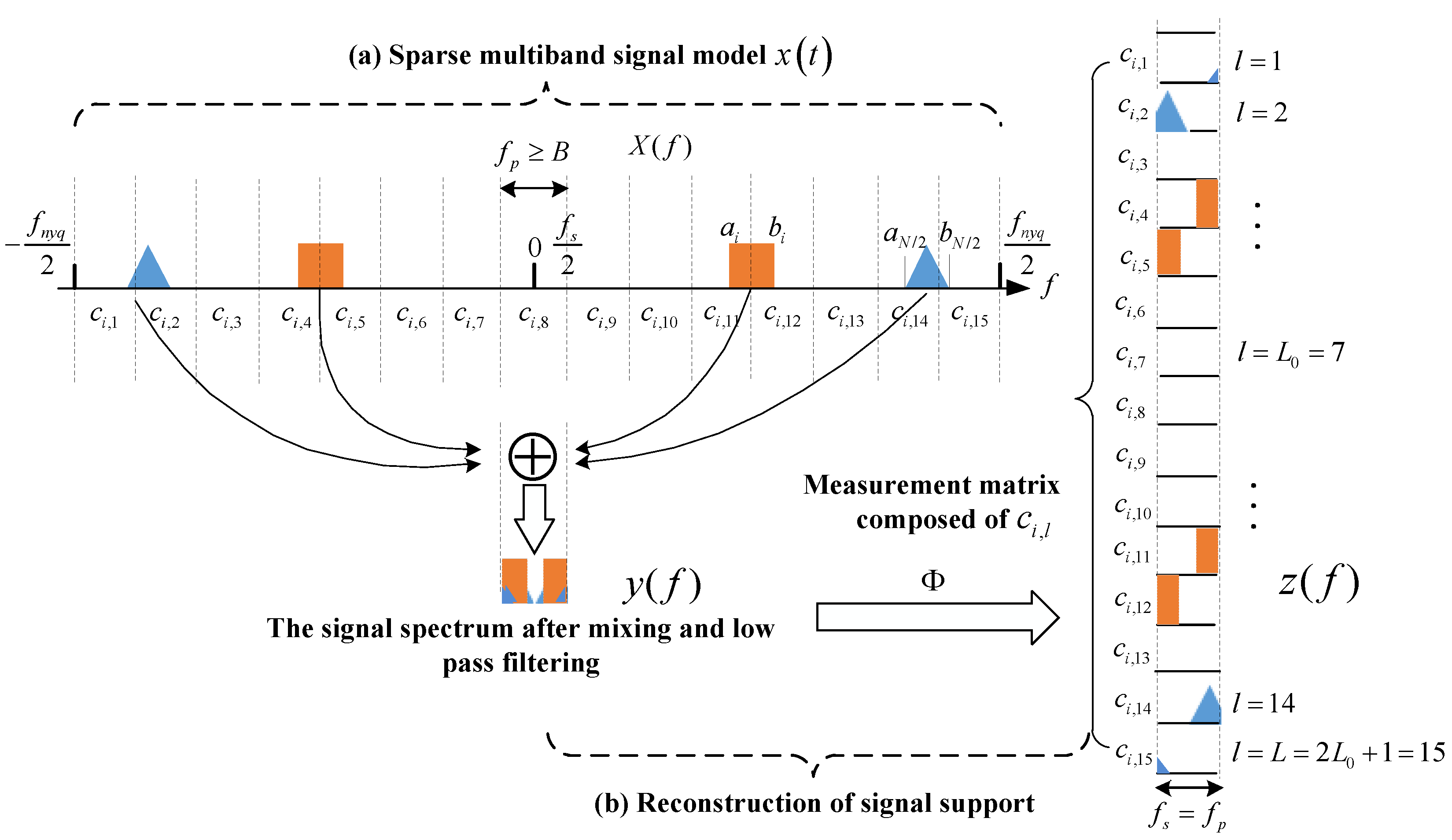
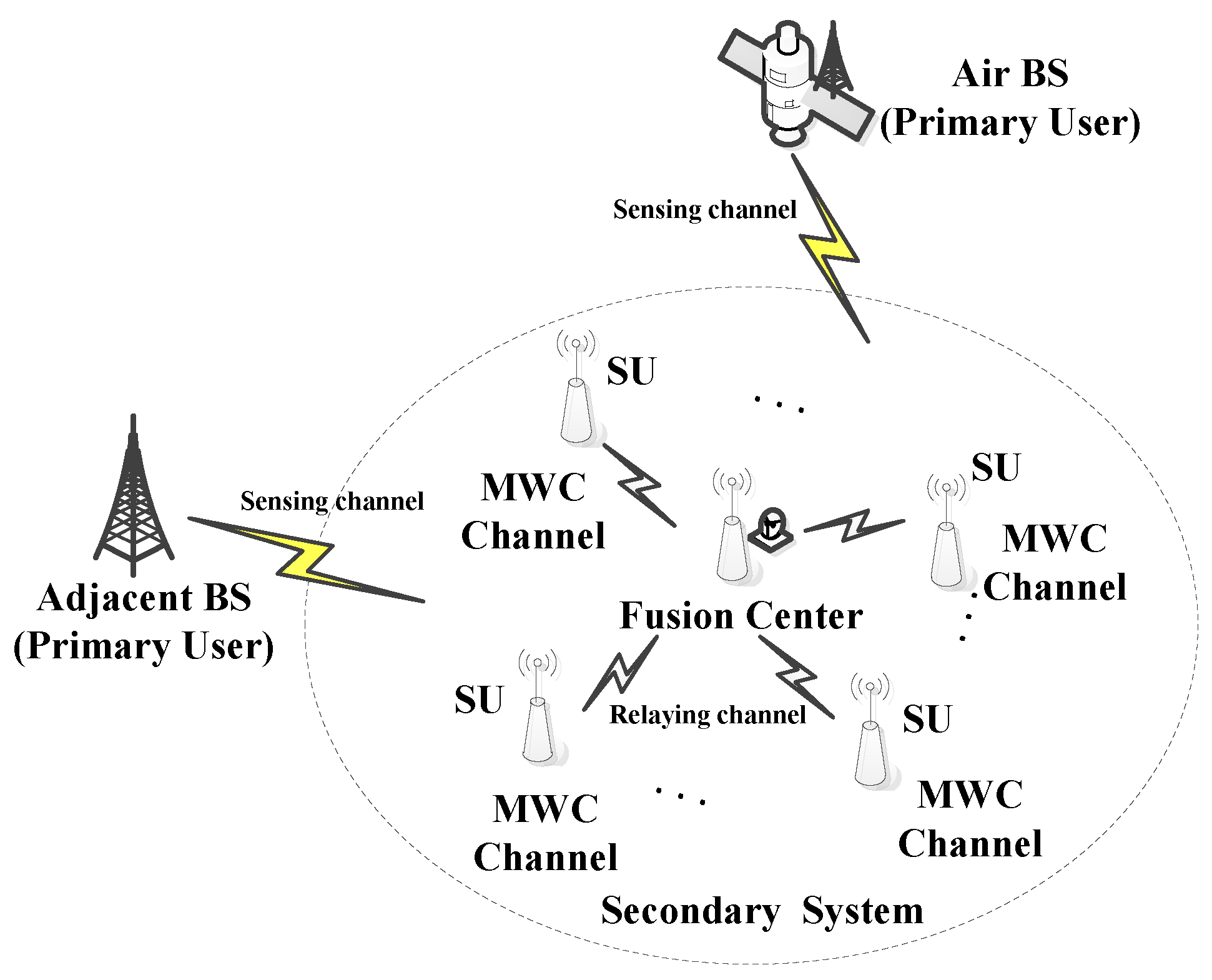




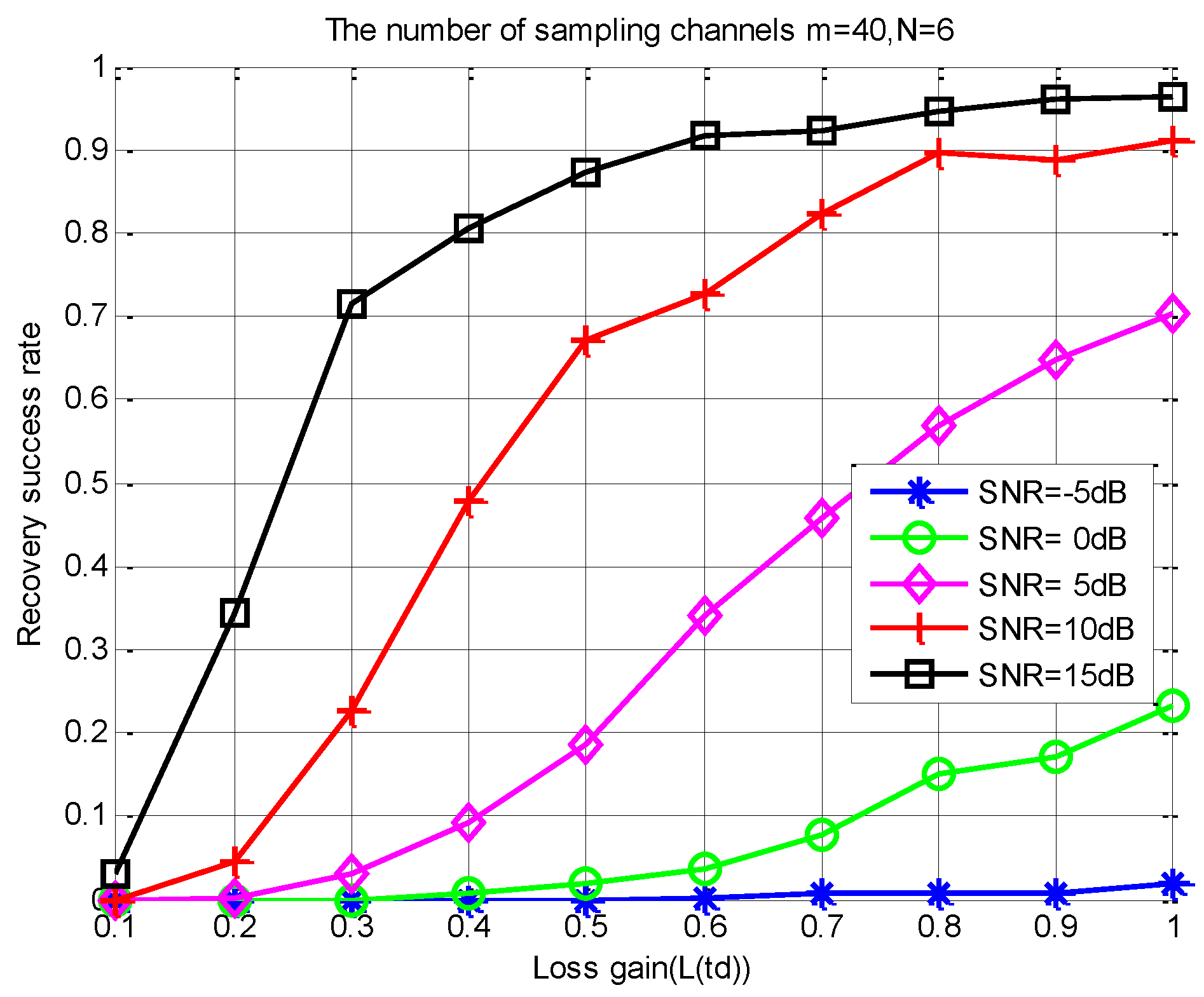
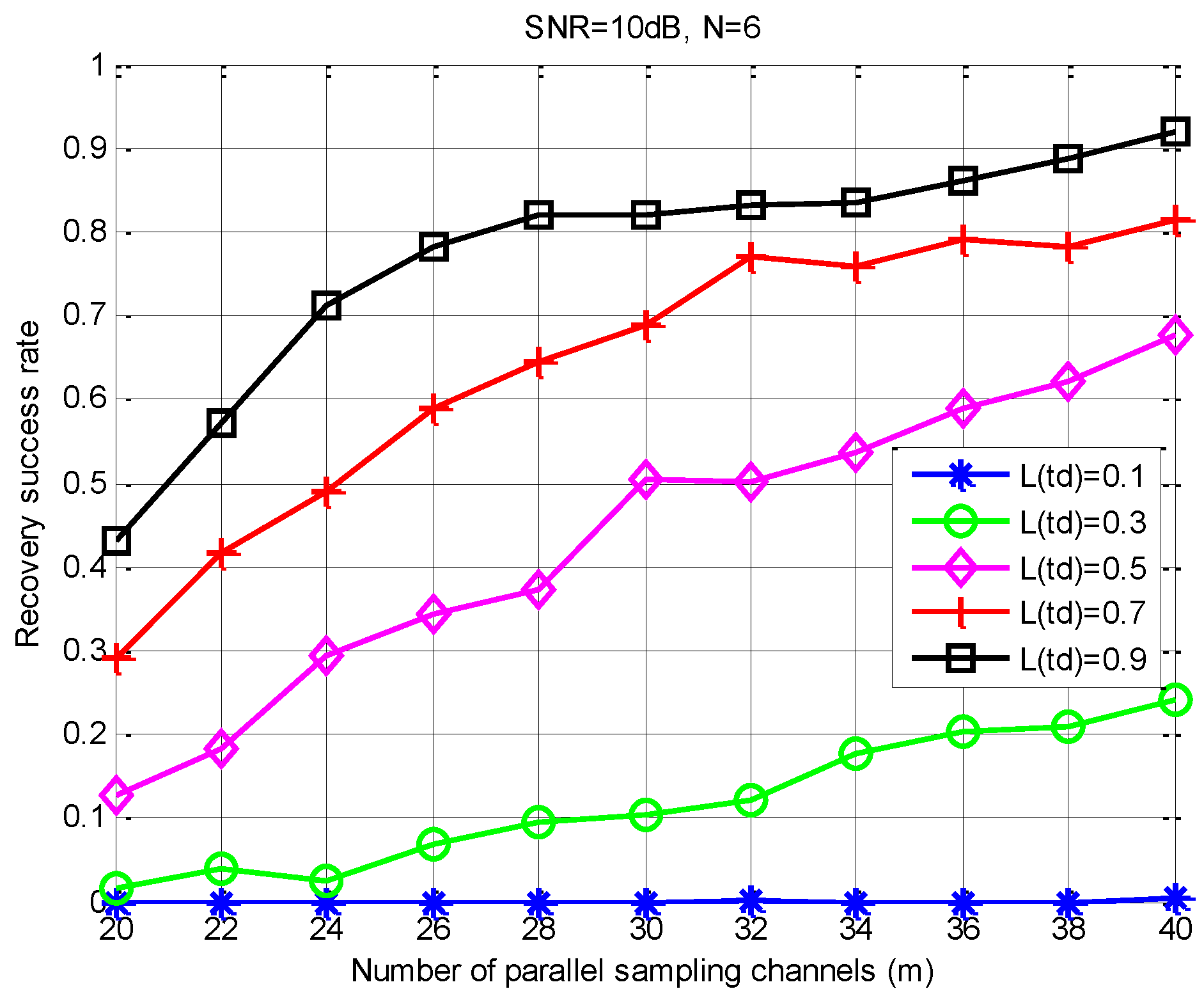
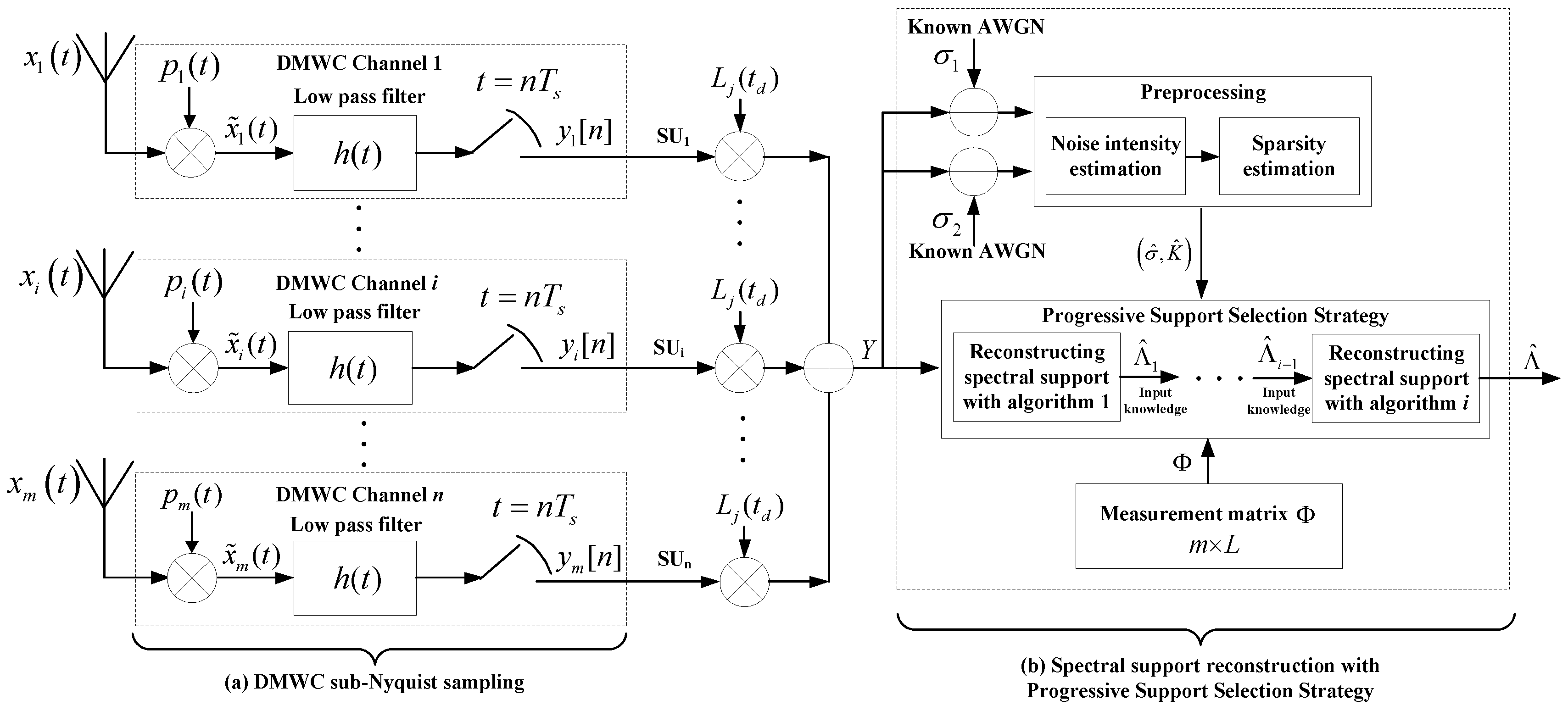
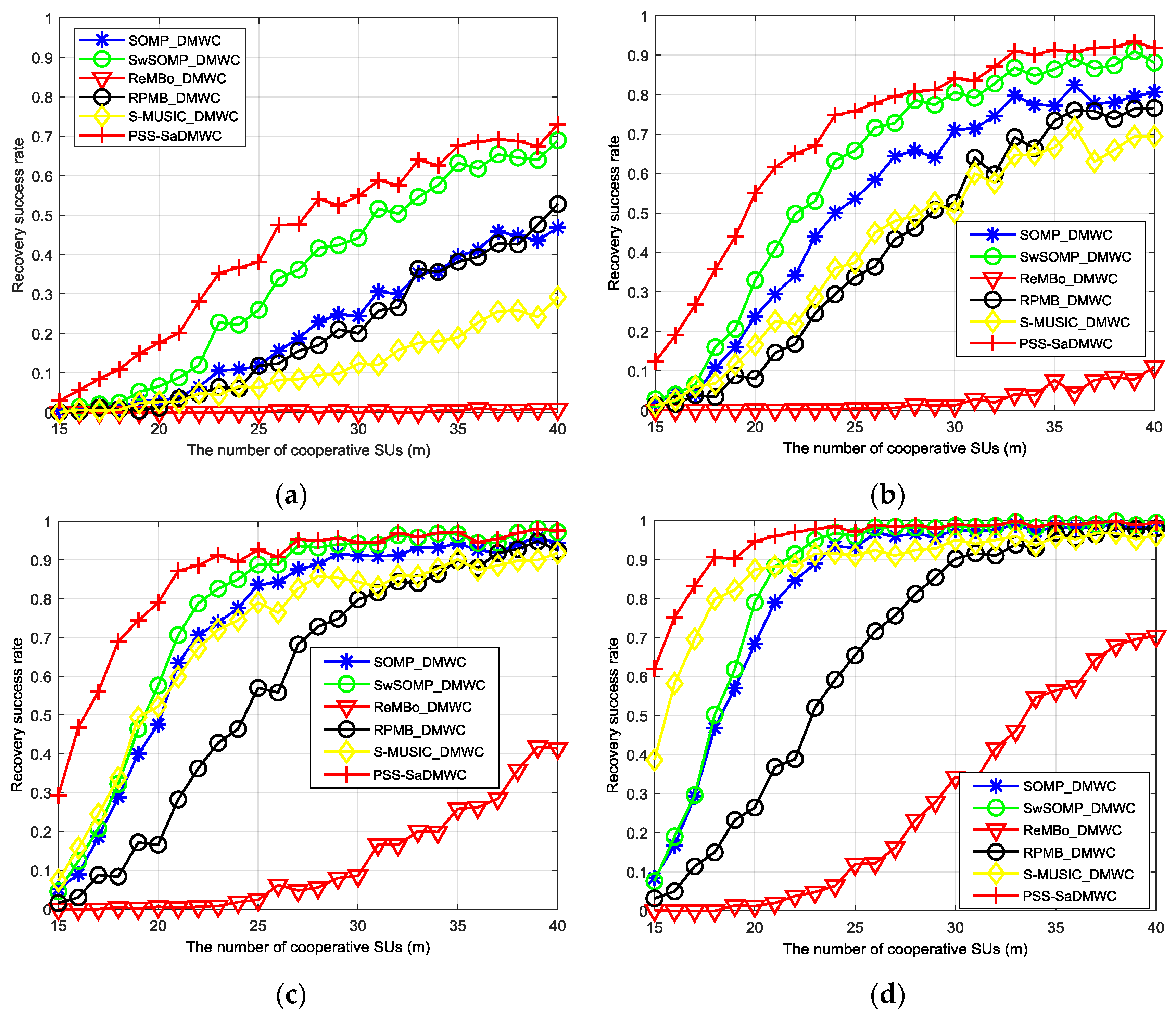
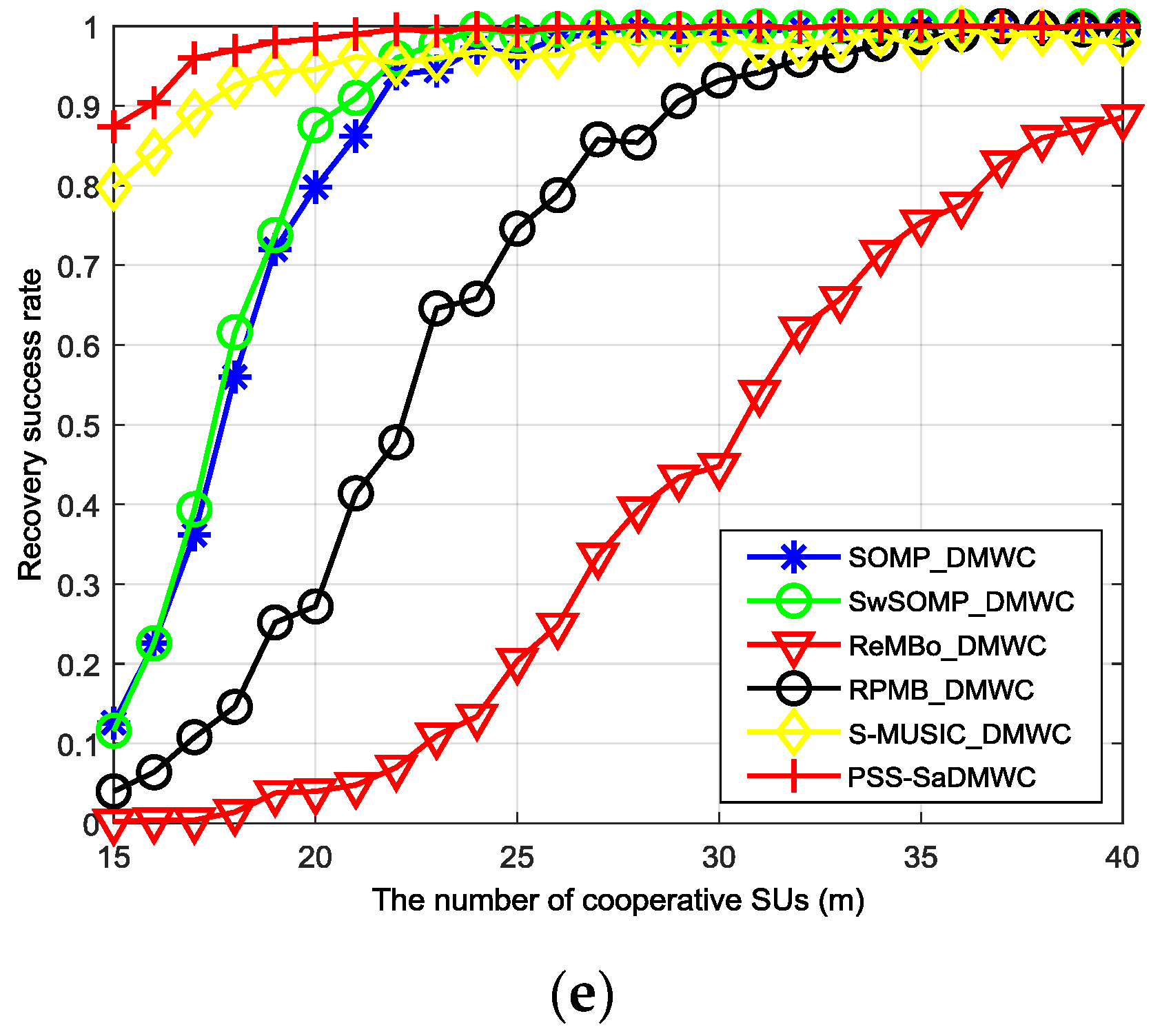
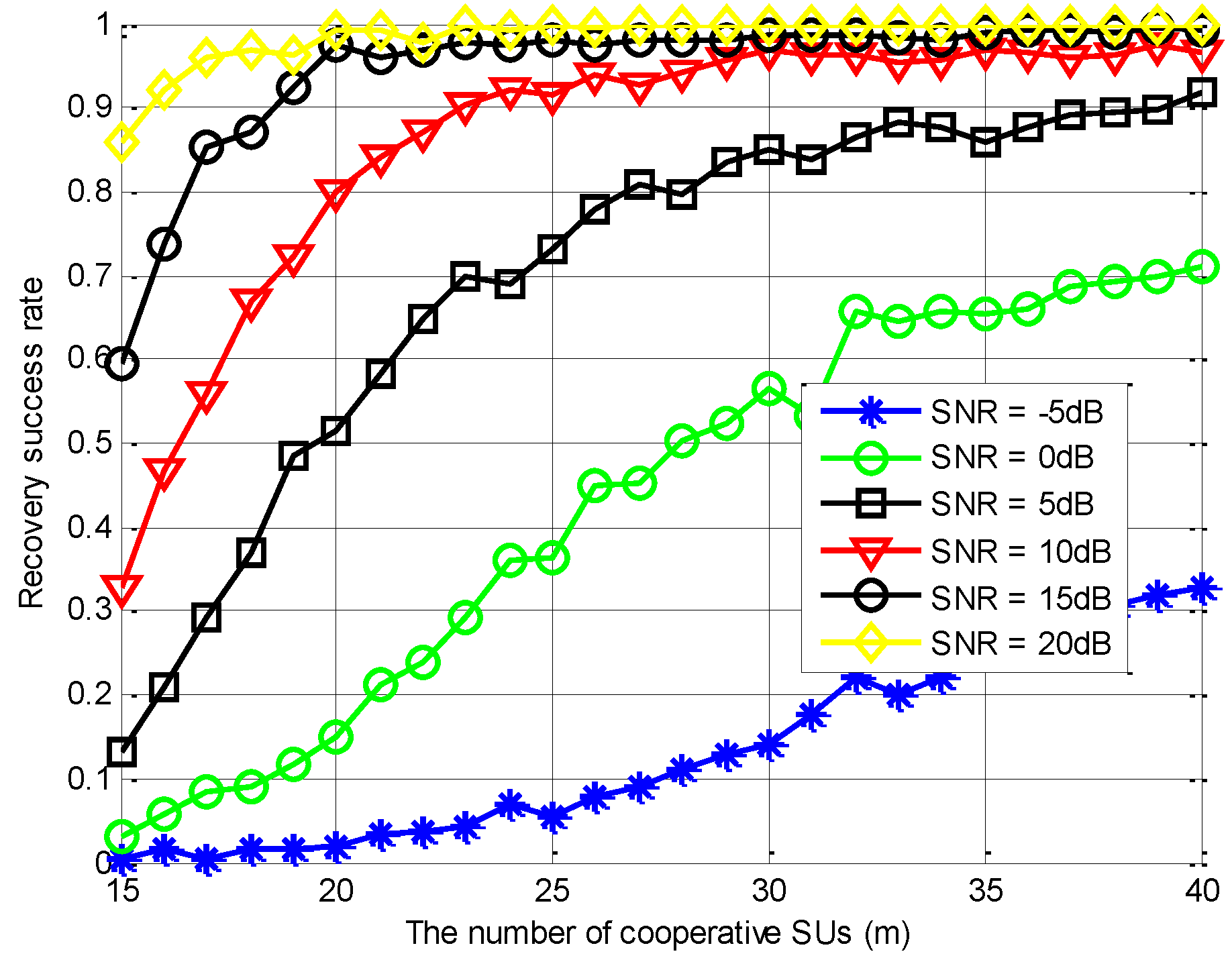

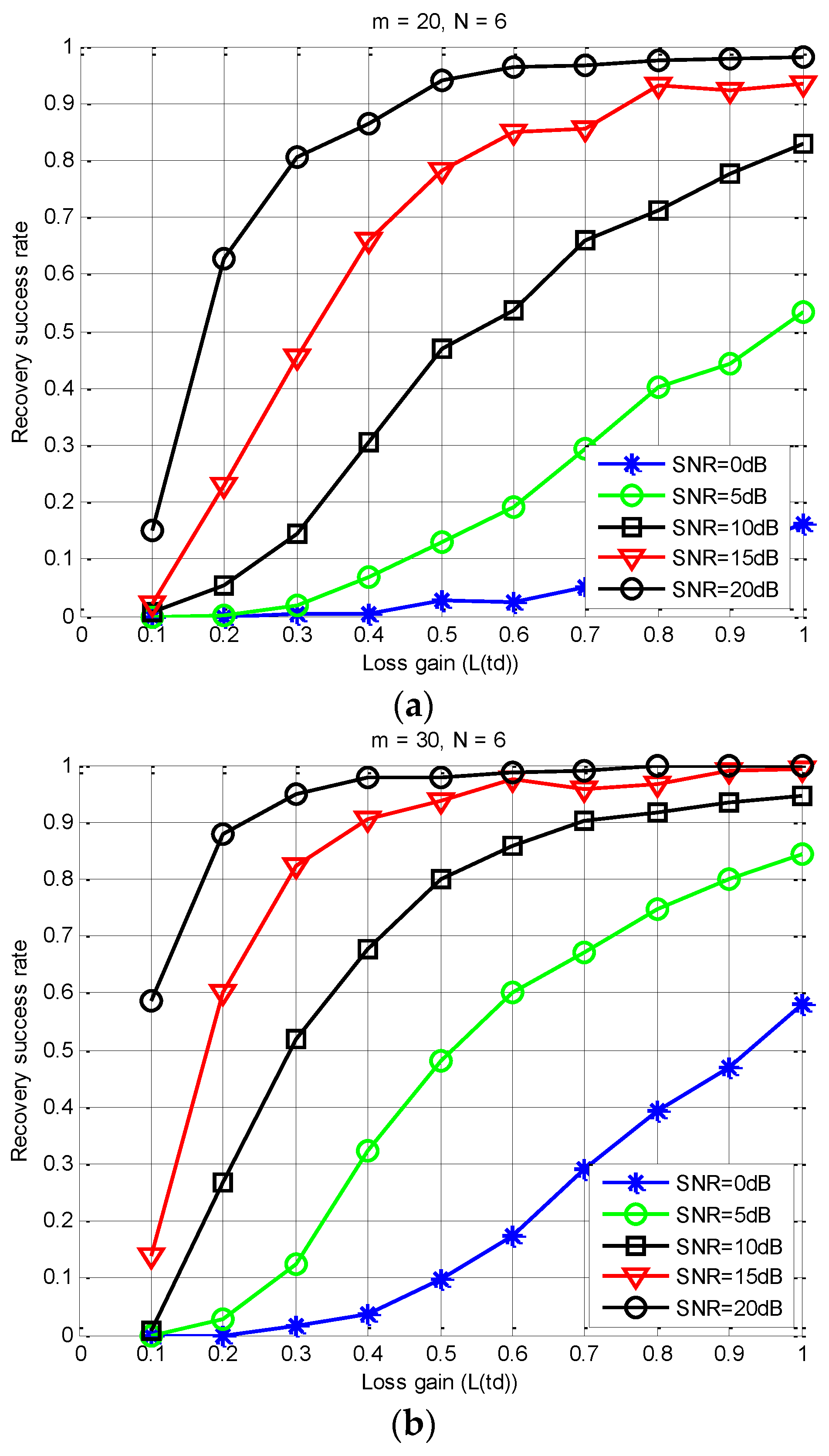
| Notation | Meaning |
|---|---|
| Actual spectral support of the signal. | |
| Temporary support obtained in Algorithm 2. | |
| Estimated spectral support. | |
| Potential of spectral support. | |
| Number of sub-bands in the multi-band signal. | |
| Bandwidth of the sub-band. | |
| Nyquist rate of . | |
| Periodic mixing signal. | |
| Sub-Nyquist sampling signal with the MWC. | |
| Sparsity order of the signal. | |
| Estimated sparsity order. | |
| Norm of each row vector for . | |
| measurement matrix or observation matrix. | |
| Extracting column vectors from according to . | |
| Decision threshold. | |
| Energy coefficient of the sub-band. | |
| Carrier frequency. | |
| Time offset of the sub-band. | |
| Spectrum slice number. | |
| Spectral slice width, . | |
| Sampling rate at each channel, , with odd . |
| Parameters | N = 6, and L(td) = 0.9 | |
|---|---|---|
| Scheme | RPMB | S-MUSIC |
| Extraction ability | 45.4% | 61.4% |
| Recovery success rate | 7.6% | 34% |
| Symbols | Value | Meanings |
|---|---|---|
| 6 | Number of sub-bands with energy (three pairs of bands) | |
| {1,2,3} | Energy of the i-th sub-band | |
| {50,50,50} MHz | Maximal width of each sub-band | |
| {0.4,0.7,0.2} | Time offset of the i-th sub-band | |
| 10 GHz | Nyquist rate | |
| 195 | Aliasing rate, or the spectrum slice number | |
| 195 | Number of intervals in each period of | |
| 51.28 MHz | Spectral slice width, | |
| 51.28 MHz | Sampling rate at each channel, , with odd | |
| 0.9 | Transmission loss gain |
| Comparison | m = 19 SNR = 5 dB | m = 18 SNR = 10 dB | m = 15 SNR = 15 dB | m = 15 SNR = 20 dB |
|---|---|---|---|---|
| PSS-SaDMWC scheme vs. the best single selection scheme | 23%↑ | 34%↑ | 22%↑ | 7.5%↑ |
| Schemes | SNR = 5 dB | SNR = 10 dB | SNR = 15 dB | SNR = 20 dB | ||||
|---|---|---|---|---|---|---|---|---|
| PSS-SaDMWC | 33 | 1692.24 | 23 | 1179.44 | 18 | 923.04 | 16 | 820.48 |
| The best single selection scheme | 39 | 1999.92 | 27 | 1384.56 | 23 | 1179.44 | 18 | 923.04 |
| Number of Bands with Energy (N) | Parameters: m = 20, SNR = 15 dB, L(td) = 0.9, Repeat 500 Times, Progressive Levels = 2. | ||||||
|---|---|---|---|---|---|---|---|
| Average Time Spent on Sub-Nyquist Sampling Process and the Support Reconstruction (/s) | |||||||
| Sub-Nyquist Sampling | SOMP_DMWC | SwSOMP_DMWC | ReMBo_DMWC | RPMB_DMWC | S-MUSIC_DMWC | PSS-SaDMWC | |
| 2 | 0.1175 | 0.0009 | 0.0010 | 0.0030 | 0.0138 | 0.0003 | 0.0046 |
| 4 | 0.1196 | 0.0014 | 0.0020 | 0.0115 | 0.0566 | 0.0004 | 0.0051 |
| 6 | 0.1187 | 0.0026 | 0.0034 | 0.0203 | 0.1260 | 0.0007 | 0.0062 |
| 8 | 0.1180 | 0.0034 | 0.0033 | 0.0266 | 0.2162 | 0.0007 | 0.0057 |
| 10 | 0.1193 | 0.0048 | 0.0036 | 0.0064 | 0.1175 | 0.0007 | 0.0062 |
| Number of Bands with Energy (N) | Parameters: m = 20, SNR = 15 dB, L(td) = 0.9, Repeat 500 times, Progressive levels = 2. | |||||
|---|---|---|---|---|---|---|
| The Total Time Spent on Different Schemes (/s) | ||||||
| SOMP_DMWC | SwSOMP_DMWC | ReMBo_DMWC | RPMB_DMWC | S-MUSIC_DMWC | PSS-SaDMWC | |
| 2 | 0.1184 | 0.1185 | 0.1205 | 0.1313 | 0.1178 | 0.1221 |
| 4 | 0.1210 | 0.1216 | 0.1311 | 0.1762 | 0.1200 | 0.1247 |
| 6 | 0.1213 | 0.1221 | 0.1390 | 0.2447 | 0.1194 | 0.1249 |
| 8 | 0.1214 | 0.1213 | 0.1446 | 0.3342 | 0.1187 | 0.1237 |
| 10 | 0.1241 | 0.1229 | 0.1257 | 0.2368 | 0.1200 | 0.1255 |
© 2018 by the authors. Licensee MDPI, Basel, Switzerland. This article is an open access article distributed under the terms and conditions of the Creative Commons Attribution (CC BY) license (http://creativecommons.org/licenses/by/4.0/).
Share and Cite
Hu, Z.; Bai, Y.; Huang, M.; Xie, M.; Zhao, Y. A Self-Adaptive Progressive Support Selection Scheme for Collaborative Wideband Spectrum Sensing. Sensors 2018, 18, 3011. https://doi.org/10.3390/s18093011
Hu Z, Bai Y, Huang M, Xie M, Zhao Y. A Self-Adaptive Progressive Support Selection Scheme for Collaborative Wideband Spectrum Sensing. Sensors. 2018; 18(9):3011. https://doi.org/10.3390/s18093011
Chicago/Turabian StyleHu, Zhuhua, Yong Bai, Mengxing Huang, Mingshan Xie, and Yaochi Zhao. 2018. "A Self-Adaptive Progressive Support Selection Scheme for Collaborative Wideband Spectrum Sensing" Sensors 18, no. 9: 3011. https://doi.org/10.3390/s18093011
APA StyleHu, Z., Bai, Y., Huang, M., Xie, M., & Zhao, Y. (2018). A Self-Adaptive Progressive Support Selection Scheme for Collaborative Wideband Spectrum Sensing. Sensors, 18(9), 3011. https://doi.org/10.3390/s18093011





